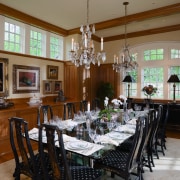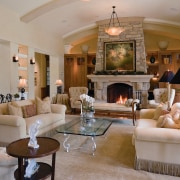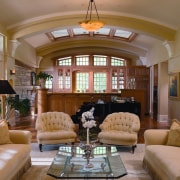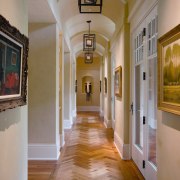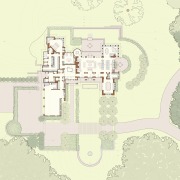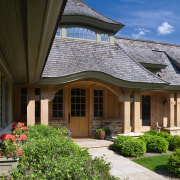Anchored to the land
With its solid stone base and sweeping eaves, this European-style farmhouse conveys a sense of enduring history

American farmhouse architecture takes many forms from the grand and imposing to more simple, humble abodes. But for the owners of this rural property, the inspiration for their home came from traditional Eastern European farmhouse architecture.
Project designer Charlie Simmons of TEA2 Architects says the owners wanted an unpretentious house that would convey a sense of history.
"The owners wanted a house that would settle into the landscape, and look as though it had been there for the past 80 years or so," he says. "After researching many different types of farmhouse architecture from all over the world, it was the Eastern European influence that really appealed."
Key features of this style include the steeply pitched, shingle roof with its low, eyebrow eaves, and the solid stone base that visually anchors the house to the landscape. Five different types of stone, including locally sourced Kasota stone, were combined to provide color variation.
"No one color dominates," says Simmons. "We have also varied the size of the stone, and the height of the base, to make it look like a house that has evolved over time. It was important that no single material would overpower the house."
Simmons says the house was positioned against a grassy knoll, with a heavy wooded area on three sides. At the front, the house opens up to rolling horse pastures.
"The house was designed to appear as though it is almost growing out of the knoll," he says. "By stepping down some of the architectural elements, such as the eaves, we were able to provide a low profile. But, at the same time, the interior space wasn't compromised the steep pitch of the roof meant we could tuck rooms into the building envelope, with dormers bringing in light."
In typical European farmhouse tradition, the eaves enclose the entrance to the house, with a deep curved overhang above the front door. Twin solid-wood columns are positioned either side of the stoop, further enhancing the sense of shelter.

The traditional farmhouse flavor continues on the interior, where barrel-vault ceilings complement the arched windows. The use of reclaimed materials also enhances the character the white oak floor features wood from old tobacco barns, complete with original nail and bolt holes. Paneling and cabinetry in the same wood provide continuity throughout the house.
An entrance gallery opens directly to the family living room although a line of large columns provides visual definition from the circulation area.
"The barrel-vault ceiling in this room ensures the space is not overpowering," says Simmons. "It was important not to overscale the space, as it needed to feel warm and welcoming the owners wanted a comfortable home that would be a base for their extended family to enjoy."
In addition to the natural light from the large windows, including those in the adjacent gallery, there is a traditional barn cupola above the kitchen island, bringing extra light into one end of the living space. Further light was provided by glass-fronted cabinets set against the windows in the kitchen.
"The kitchen is a backdrop to the living room, so it plays an important architectural role," says Simmons. "With its curved top, the window cabinetry is almost like a furniture piece. The light filtering through the glass also helps to show off the owners' crystal collection."
Other features of the family living area include a large stone fireplace, which forms a sculptural element at the opposite end to the kitchen.
Interior designer Renee LeJeune Hallberg, of BesonKading Interior Design, says the interior was designed to reflect the owners' desire for an understated, yet serene and welcoming home.
"The owners wanted a quiet, monochromatic look, hence the neutral color palette. Textural items add visual interest, and a variety of different trims, pillow fabrics and artworks were introduced to provide color and character."

The formal dining room has a similar color palette, but sparkling chandeliers and black-painted chairs with gold chinoiserie add a touch of formality. The high wood paneling in this room was determined by the typical height of the plate railing in a 100-year-old farmhouse, which was positioned out of the reach of children.
Another traditional feature is the porch next to the kitchen. Designed as a cozy, intimate family space, the room features a rift-sawn white oak vaulted ceiling. The structural beams have also been exposed to enhance the country look.
"The rift-sawn wood is not as linear as straight, quarter-sawn timbers," says Simmons. "It provides a natural grain, which gives the space a more organic feel."
Simmons says the porch was designed as a multi-seasonal room. In summer, the triple-hung windows can be raised to open up the entire space, much like a conventional screened porch.
"This living space has been decorated in typical farmhouse style," says Hallberg. "Green-washed, rush-seat chairs with ladder backs, a wool rug, and a wooden trestle table all enhance that look."
Hallberg says the interior was designed to accommodate the owners' favorite artworks. It was also laid out according to Feng Shui principles, which determined the angled layout of the master bedroom on the ground floor. This room incorporates an alcove sitting room, complete with Barbara Barry slipper chairs. And, as with every room in the house, the bedroom commands a picturesque view of the surrounding countryside.
Credit list
Interior designer
Structural engineer
Roofing
Flooring
Paints
Home theater and automated blinds
Countertops
Oven, cooktop and ventilation
Bathroom basin
Story by: Trendsideas
Home kitchen bathroom commercial design
Diving into nature
Classic looks, contemporary efficiency
Personality plus

